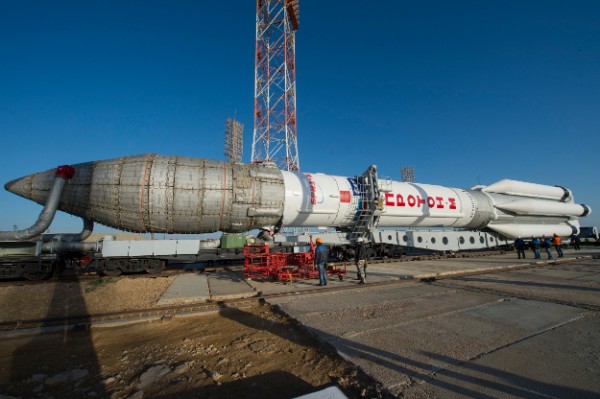By Ana Verayo, | March 13, 2016

Roscosmos' Proton rocket that will launch the ExoMars mission tomorrow.
A European-Russian space mission will blast off to Mars on Monday, as a rocket will carry an orbiter that will launch a lander on the surface of the Red Planet.
This joint Mars mission is a collaboration between the European Space Agency and Russia's Roscosmos where a Proton rocket will launch the ExoMars Trace Gas Orbiter (TGO) and the Schiaparelli lander. The rocket and the orbiter along with the lander will blast off from the Baikonur Cosmodrome in Kazakhstan, Central Asia.
Like Us on Facebook
The main focus of this mission is to obtain samples and analyze the Red Planet's atmosphere for signs of microbial life. According to ESA officials, the ExoMars Orbiter will be inserted in an elliptical orbit around Mars that will work by scanning the atmosphere where it can finally settle into its a circular orbit with an altitude of 400 meters from the surface, carrying out its scientific mission.
Mission scientists also say that the main objectives of this mission is to search for enough evidence of methane and other trace gases in the atmosphere that can hint at signatures of active biological and geological processes of the planet. The mission also aims to test new technology in preparation for ESA's future missions to Mars.
By October, the orbiter and the lander will arrive in Mars after journeying for more than 300 million miles. After three days of the orbiter settling itself into the orbit of Mars, the lander Schiaparelli will be deployed by the mothership orbiter, which is then expected to land on the surface of Mars on October 19.
The lander is carrying a suite of scientific instruments for a week of activities, as ESA engineers are testing the lander about how will it perform during atmospheric entry, descent and touchdown on the target landing area, to gain data about how to control this landing apparatus for the next missions to Mars.
Upon ejecting the Schiaparelli on Mars, the TGO will still orbit around the planet, where it will perform different maneuvers from 250 miles above the surface. Using orbiter data, ESA scientists can apply this to the second ExoMars mission which is slated to launch in 2018 that can also provide data relay for NASA rovers.
The orbiter's main goal is analyze the presence of Martian methane, which is a gas present on Earth that is expelled by living microbes and organisms, as traces of this were observed in past Martian missions. However, on Mars, an organic molecule could be destroyed easily due to the harsh, radioactive environment of the planet which suggests that these methane molecules can originate from a replenishing biological or geological source.
According to ExoMars project scientist, Jorge Vago, there are no exact explanations yet, but all evidence point to the existence of liquid water in the subsurface of Mars that can slightly alter how we see Mars, from an ancient, dusty planet devoid of life to a slightly active one that might reveal a hidden ecosystem.
-
Use of Coronavirus Pandemic Drones Raises Privacy Concerns: Drones Spread Fear, Local Officials Say

-
Coronavirus Hampers The Delivery Of Lockheed Martin F-35 Stealth Fighters For 2020

-
Instagram Speeds Up Plans to Add Account Memorialization Feature Due to COVID-19 Deaths

-
NASA: Perseverance Plans to Bring 'Mars Rock' to Earth in 2031

-
600 Dead And 3,000 In The Hospital as Iranians Believed Drinking High-Concentrations of Alcohol Can Cure The Coronavirus

-
600 Dead And 3,000 In The Hospital as Iranians Believed Drinking High-Concentrations of Alcohol Can Cure The Coronavirus

-
COVID-19: Doctors, Nurses Use Virtual Reality to Learn New Skills in Treating Coronavirus Patients







